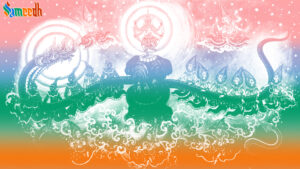The Samudra Manthan, also known as the Churning of the Ocean, is a significant episode in Hindu mythology found in several ancient texts, including the Puranas. The story narrates the churning of the ocean by the Devas (celestial beings) and Asuras (demons) to obtain the nectar of immortality (amrita). The churning is a pivotal event that involves the use of Mount Mandara as the churning rod and Vasuki, the serpent king, as the churning rope.

The Samudra Manthan explores themes of cooperation, cosmic balance, and the eternal struggle between good and evil, weaving a tale rich in symbolism and philosophical depth within Hindu cosmology.
Here is a detailed version of the Samudra Manthan story:
- Context and Motivation:
- The Devas and Asuras were engaged in a constant struggle for supremacy.
- The Devas, led by Lord Indra, had been defeated by the powerful Asuras.
- Seeking to regain their lost power, the Devas approached Lord Vishnu for help.
- Vishnu advised them to seek the cooperation of the Asuras in churning the ocean to obtain the nectar of immortality.
- The Agreement:
- Both Devas and Asuras agreed to churn the ocean together, with the understanding that they would share the benefits equally.
- Churning Begins:
- Mount Mandara was chosen as the churning rod, and it was placed in the middle of the ocean.
- The serpent Vasuki, a devotee of Lord Shiva, volunteered to serve as the churning rope.
- The Devas held the tail of Vasuki, and the Asuras held the head.
- As the churning began, Mount Mandara started to sink into the ocean.
- Vishnu’s Assistance:
- Seeing the mount sinking, Lord Vishnu incarnated as Kurma, the turtle, and supported Mount Mandara on his back.
- This ensured that the churning process could continue without interruption.
- Emergence of Poison:
- As the churning progressed, the first substance to emerge from the ocean was a deadly poison known as Halahala.
- The poison threatened to destroy all of creation.
- Lord Shiv came to the rescue and swallowed the poison, which turned his throat blue, earning him the name Neelakanth.
- Appearance of Divine Objects:
- Despite the initial challenges, the churning continued, and several divine objects emerged from the ocean.
- These included the wish-fulfilling cow Kamadhenu, the celestial elephant Airavata, the goddess Lakshmi (Shri), the moon, and the precious gem known as Kaustubha.
- Amrita Appears:
- Finally, Dhanvantari, the physician of the gods, emerged carrying a pot of amrita (nectar of immortality).
- The Devas and Asuras eagerly sought the amrita to attain immortality.
- Deception and Battle:
- The Asuras, fearing deception, demanded that they receive the entire pot of amrita.
- Lord Vishnu took the form of Mohini, a enchanting female, to distract the Asuras.
- While the Asuras were enchanted, Vishnu distributed the amrita among the Devas.
- Demon Swallowing the Nectar:
- One Asura, named Rahu, disguised himself as a Deva and managed to drink a few drops of amrita before being discovered by the Sun and the Moon.
- Vishnu beheaded Rahu, but since he had consumed the nectar, he became immortal and his head continued to exist as Rahu.
- Consequences:
- The Devas, having consumed the amrita, gained great strength and defeated the Asuras.
- This event reinforced the eternal conflict between the Devas and Asuras but established the supremacy of the Devas in the heavenly realms.
The Samudra Manthan is a rich and symbolic narrative with profound spiritual and philosophical meanings. It explores themes of cooperation, cosmic balance, the eternal struggle between good and evil, and the quest for immortality. The story is a testament to the intricate interconnectedness of the Hindu pantheon and the profound symbolism embedded in its myths.
